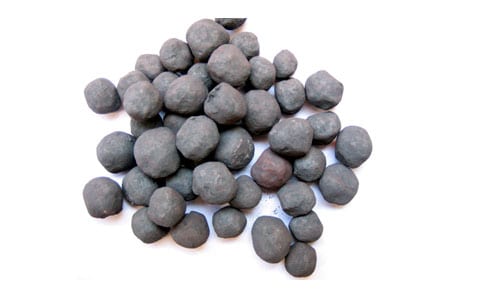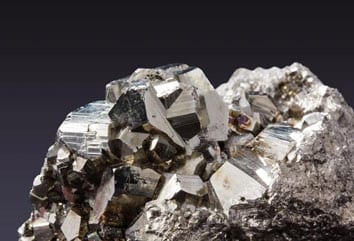Izaberite jezik:
Iron ore is the fourth most common element in the earth’s crust. Iron is essential to steel manufacturing and, zbog toga, an essential material for global economic development. Gvožđe se takođe široko koristi u građevinarstvu i proizvodnji vozila. Most iron ore resources are composed of metamorphosed banded iron formations (BIF), u kojoj se gvožđe obično nalazi u obliku oksida, hydroxides, i, to a lesser extent, carbonates.
The chemical composition of iron ores is apparent to be wide, especially for Fe content and associated gangue minerals. Major iron minerals associated with most iron ores are hematite, getit, limonite, and magnetite. Glavni kontaminanti u rudama gvožđa su SiO2 i Al2O3. The typical silica and alumina-bearing minerals present in iron ores are quartz, Kaolinitisani, gibbsite, dijaspora, i corundum. Od ovih, it is often observed that quartz is the main silica-bearing mineral, and kaolinite and gibbsite are the two main alumina-bearing minerals.


Vađenje rude gvožđa se uglavnom vrši kroz otvorenu jamu rudarske operacije, što rezultira značajnom generacijom krojenja. Sistem proizvodnje rude gvožđa obično uključuje tri faze: Rudarstvo, obrada, and pelletizing activities. Processing ensures that an adequate iron grade and chemistry are achieved prior to the pelletizing stage. Obrada uključuje razbijanje, Klasifikacija, mlevenje, and concentration, with the aim of increasing the iron content while reducing the amount of gangue minerals. Each mineral deposit has its own unique characteristics with respect to iron and gangue-bearing minerals, and therefore, it requires a different concentration technique.
Magnetic separation is typically used in high-grade iron ore beneficiation, where the dominant iron minerals are ferro and paramagnetic. Vlažno i suvo magnetno odvajanje niskog intenziteta (LIMS) techniques are used to process ores with strong magnetic properties, such as magnetite, while wet high-intensity magnetic separation is used to separate the Fe-bearing minerals with weak magnetic properties, such as hematite, from gangue minerals. Iron ores such as goethite and limonite are commonly found in tailings and do not separate very well by either technique.

Flotacija se koristi za smanjenje sadržaja nečistoća u rudama gvožđa nižeg razreda. Rude gvožđa se mogu koncentrisati ili direktnom anionom flotacijom oksida gvožđa ili obrnutom cationic flotacijom silikona; Međutim, reverse cationic flotation remains the most popular flotation route used in the iron industry. The use of flotation is limited by the cost of reagents, the presence of silica and alumina-rich slimes, and the presence of carbonate minerals. Pored toga, flotation requires wastewater treatment and the use of downstream dewatering for dry final applications.
The use of flotation for the concentration of iron also involves desliming, as floating in the presence of fines results in decreased efficiency and high reagent costs. Desliming je posebno kritičan za uklanjanje aluminijuma jer je odvajanje gibsita od hematita ili goetita od strane bilo kog površinski aktivnog agenta prilično teško. Most alumina-bearing minerals occur in the finer size range (<20Hm), omogućavanje njegovog uklanjanja kroz destimulatisanje. Ukupna, visoka koncentracija novčanih kazni (<20Hm) a aluminijum povećava potrebnu dozu cationic collectora i drastično smanjuje selektivnost. Zbog toga, desliming increases flotation efficiency but results in a large volume of tailings and in loss of iron to the tailings stream.
Suva obrada rude gvožđa predstavlja priliku za eliminisanje troškova i vlažnih kroja generacija povezanih sa flotacionim i vlažnim magnetnim separacionim sklopovima. STET has evaluated several iron ore tailings and run-of-mine ore samples at bench scale (Skala izvodljivosti pre izvodljivosti). Primećeno značajno kretanje gvožđa i silikata, sa primerima istaknutim u tabeli ispod.

Rezultati ove studije pokazali su da se kazne za rudu gvožđa nižeg razreda mogu nadograditi pomoću STET tribo-elektrostatičkog separatora pojasa. Zasnovano na STET iskustvu, oporavak proizvoda i/ili ocena će se značajno poboljšati u obradi pilotske skale, u poređenju sa test uređajem na klupi koji je korišćen tokom ovih ispitivanja rude gvožđa.
STET suvi elektrostatički fino odvajanje rude gvožđa Proces nudi mnoge prednosti u odnosu na tradicionalne metode mokre obrade, kao što su magneti ili flotacija, Uključujući:
Kontaktirajte nas da biste saznali više o Suva obrada rude gvožđa.
Reference:
Iron ore beneficiation involves a series of processes that aim to improve the purity and quality of raw iron ore. These processes include crushing, grinding, magnetno razdvajanje, SkIoni, and gravity separation, depending on the mineralogical characteristics of the ore. Each technique is selected based on the ore’s composition and feasibility to extract the maximum amount of iron while minimizing impurities.
Iron ore mining requires specialized equipment to handle the extraction and processing of ore. Common machinery includes ball mills for grinding, crushers for reducing the size of ore, magnetic separators for separating iron particles from impurities, flotation machines for fine particle separation, and conveyors for transport.
Technologies utilized for iron ore beneficiation include advanced techniques such as dry electrostatic separation, SkIoni, advanced gravity separation, and sensor-based sorting. These technologies aim to efficiently increase the iron content and eliminate contaminants, catering to the growing demand for high-grade iron ore and promoting sustainable mining practices.
The cost of iron ore beneficiation can vary significantly depending on the specific processes and technologies used, the grade of the raw ore, and the desired purity of the final product. It encompasses capital expenditure (CAPEX), such as equipment and plant construction, and operational expenditure (KOJA), including labor, Energije, i potrošna. It’s essential for companies to evaluate these costs against prospective revenue and market demands to ensure project viability.